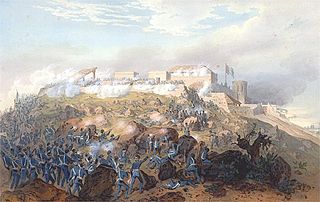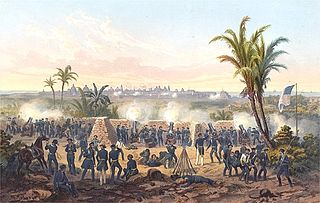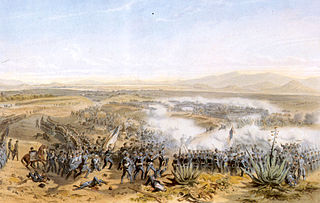Related Research Articles

Cerro Gordo County is a county located in the U.S. state of Iowa. As of the 2010 census, the population was 44,151. The current population is around 42,066 as of 2021. Its county seat is Mason City. The county is named for the Battle of Cerro Gordo, which took place during the Mexican–American War.

The Battle of Chapultepec was an assault by invading American forces on a small contingent of Mexican forces holding the strategically located Chapultepec Castle just outside Mexico City, fought 13 September 1847 during the Mexican–American War. The building, sitting atop a 200-foot (61 m) hill, was an important position for the defense of the city.

The Battle of Buena Vista, known as the Battle of La Angostura in Mexico, and sometimes as Battle of Buena Vista/La Angostura, was a battle of the Mexican–American War. It was fought between the US invading forces, largely volunteers, under General Zachary Taylor, and the much larger Mexican Army under General Antonio López de Santa Anna. It took place near Buena Vista, a village in the state of Coahuila, about 12 km (7.5 mi) south of Saltillo, Mexico. La Angostura was the local name for the site. The outcome of the battle was ambiguous, with both sides claiming victory. Santa Anna's forces withdrew with war trophies of cannons and flags and left the field to the surprised American forces, who had expected there to be another day of hard fighting.

The Battle of Veracruz was a 20-day siege of the key Mexican beachhead seaport of Veracruz during the Mexican–American War. Lasting from March 9–29, 1847, it began with the first large-scale amphibious assault conducted by United States military forces, and ended with the surrender and occupation of the city. U.S. forces then marched inland to Mexico City.

Richard James Oglesby was an American soldier and Republican politician from Illinois. He served in the United States Army during the Mexican–American War of 1846–47, and after the war became a prospector during the California Gold Rush and was elected to the Illinois General Assembly. During the American Civil War, Oglesby volunteered for the Union Army and rose to the rank of major general, serving in the Western Theater; he left the army when he was elected Governor of Illinois in 1864, and would serve three non-consecutive terms in that office. He also served as a United States Senator from Illinois from 1873 to 1879.

The Battle of Cerro Gordo, or Battle of Sierra Gordo, was an engagement in the Mexican–American War on April 18, 1847. The battle saw Winfield Scott's United States troops outflank Antonio López de Santa Anna's larger Mexican army, driving it from a strong defensive position.

Gordon Granger was a career U.S. Army officer and a Union general during the American Civil War, where he distinguished himself at the Battle of Chickamauga. Granger is best remembered for his June 19, 1865 proclamation in Texas that all slaves are free, commemorated today by the Juneteenth celebration.

The Battle of Contreras, also known as the Battle of Padierna, took place on 19–20 August 1847, in one of the final encounters of the Mexican–American War, as invading U.S. forces under Winfield Scott approached the Mexican capital. American forces surprised and then routed the Mexican forces General Gabriel Valencia, who had disobeyed General Antonio López de Santa Anna's orders for his forces' placement. Although the battle was an overwhelming victory for U.S. forces, there are few depictions of it in contemporary popular prints. The armies re-engaged the next day in the Battle of Churubusco.

The Battle for Mexico City refers to the series of engagements from September 8 to September 15, 1847, in the general vicinity of Mexico City during the Mexican–American War. Included are major actions at the battles of Molino del Rey and Chapultepec, culminating with the fall of Mexico City. The U.S. Army under Winfield Scott scored a major success that ended the war.
The following are synopsis of the campaigns of the Mexican–American War (1846—1848).

Gabriel René Paul was a career officer in the United States Army most noted for his service during the Seminole Wars and the Mexican–American War and as a Union Army general in the American Civil War.

Edmund Brooke Alexander was an officer in the United States Army in the Mexican-American War through the American Civil War who rose to the rank of brevet Brigadier General in 1865.

The Mexican–American War, also known in the United States as the Mexican War and in Mexico as the Intervención Estadounidense en México, was an armed conflict between the United States and Mexico from 1846 to 1848. It followed the 1845 U.S. annexation of Texas, which Mexico considered Mexican territory since the Mexican government did not recognize the Velasco treaty signed by Mexican General Antonio López de Santa Anna when he was a prisoner of the Texian Army during the 1836 Texas Revolution. The Republic of Texas was de facto an independent country, but most of its citizens wished to be annexed by the United States. Domestic sectional politics in the U.S. were preventing annexation since Texas would have been a slave state, upsetting the balance of power between Northern free states and Southern slave states. In the 1844 United States presidential election, Democrat James K. Polk was elected on a platform of expanding U.S. territory in Oregon and Texas. Polk advocated expansion by either peaceful means or by armed force, with the 1845 annexation of Texas furthering that goal by peaceful means. However, the boundary between Texas and Mexico was disputed, with the Republic of Texas and the USA asserting it to be the Rio Grande River and Mexico claiming it to be the more-northern Nueces River. Both Mexico and the USA claimed the disputed area and sent troops. Polk sent U.S. Army troops to the area; he also sent a diplomatic mission to Mexico to try to negotiate the sale of territory. U.S. troops' presence was designed to lure Mexico into starting the conflict, putting the onus on Mexico and allowing Polk to argue to Congress that a declaration of war should be issued. Mexican forces attacked U.S. forces, and the United States Congress declared war.

Antonio de Padua María Severino López de Santa Anna y Pérez de Lebrón, usually known as Santa Anna or López de Santa Anna, was a Mexican politician and general. His influence on post-independence Mexican politics and government in the first half of the nineteenth century is such that historians of Mexico often refer to it as the "Age of Santa Anna".
James Vote (Voty) Bomford was a distinguished soldier in the United States military and a Union officer in the Civil War, and retired with the rank of Brigadier General. He graduated from Norwich University in 1828 and from West Point in 1832, and was a colonel in the 8th United States Infantry. Bomford was twice wounded in action at Perryville and served in the Mexican–American War. His father was George Bomford, an inventor and military officer in the United States Army, who invented the Columbiad cannon. His son, also named George, was expelled but allowed to retire following his involvement in the Eggnog Riot at West Point. George did enter the military and retired as a captain.
Joseph Nelson Garland Whistler was a career United States Army officer. He served in the Mexican–American War and received a brevet appointment for distinguished service in the Battle of Contreras and the Battle of Churubusco. At the beginning of the American Civil War, Whistler was among the U.S. Regular Army officers taken prisoner by Confederates in Texas in April 1861 and paroled but was not exchanged until August 15, 1862. In 1863, he became colonel of the 2nd New York Heavy Artillery Regiment. He received a promotion and four brevet appointments in the regular army for his service during the Overland Campaign, specifically the Battle of North Anna, and the Siege of Petersburg, specifically the Second Battle of Petersburg. He was nominated on January 13, 1866 and confirmed on March 12, 1866 for appointment to the grade of brevet brigadier general of volunteers, to rank from March 13, 1866. He retired in on October 19, 1886 as colonel of the 15th U.S. Infantry Regiment.
The following units and commanders of the U.S. and Mexican armed forces fought in the battle of Cerro Gordo from April 17–18, 1847 during the Mexican–American War. The U.S. 1st Division and 1st Brigade, 3rd Division remained in the rear at Veracruz.
Jacob Wallace was a pro-Mexican guerrilla leader in the Mexican–American War.

Henry Boynton Clitz was a career United States Army officer who served with distinction during the Mexican–American and Civil wars, for which he received brevet appointments. After his release as a prisoner of war from the Confederate Libby Prison in Richmond, Virginia, on July 17, 1862, Clitz was Commandant of Cadets at the United States Military Academy at West Point, New York, from October 23, 1862 to July 4, 1864. He was nominated and confirmed for appointment as a brevet brigadier general in the Regular Army on March 2, 1867, to rank from March 13, 1865. He retired from the Regular Army as a colonel of the 10th Infantry Regiment on July 1, 1885. Clitz, whose deteriorating mental state had been noticed by relatives for several months, disappeared at Niagara Falls, New York, and was presumed drowned on October 30, 1888.

Mexican Brigadier General Antonio de Leon was born in Huajuapan, Oaxaca, on June 4, 1794. He commanded the Oaxaca National Guard during the Mexican–American War (1846-1848).
References
- ↑ Terry's Guide to Mexico, 1909, page 506 (continued to be mentioned in other editions, at least throughout 1947)
- ↑ "Oglesby Mansion in Decataur, IL". Archived from the original on 2014-10-19. Retrieved 2011-02-22.
- ↑ Illinois State Military Museum Archived 2011-05-09 at the Wayback Machine
- ↑ Terry's Guide to Mexico, 1909, p. 506.